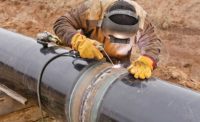The evolution of pipe-joining methods and technologies continues as manufacturers report a renewed effort to work at the engineering level.
Companies such as Uponor, Viega and Victualic say, along with increased product portfolios, the training of engineers is key in the growth of pipe-joining in commercial applications.
Uponor
Dan Worm, a CPF and plumbing product specialist with Uponor, says the Apple Valley, Minn.-based manufacturer has expanded its ProPEX pipe joining method to the commercial market. Uponor has been pleased with the initial results, but Worm says the push to get designers comfortable with the technique is ongoing.
“We are changing the way we go about business and who our target audience is,” he says. “We are focusing on the designers, engineers and building owners from a warranty standpoint.
“It is an educational thing. Engineers are so used to designing with copper piping. All the codebooks and tables are based off copper fusion, so engineers get used to those numbers. Whenever we introduce a new product it is foreign territory for them. We have to make sure we are comfortable and we are providing them with the proper data so the system will perform as it is designed.”
The desire for reduced installation time has been critical for manufacturers. Uponor reports it has enjoyed success with its ASTM-F1960 polypropylene pipe. “It is a lot faster,” Worm says. “From an engineering standpoint, it is a very reliable system.”
Viega
Derek Bower, product director of metal systems with Viega, says the company has positioned itself with a water-quality initiative that targets the high-risk segments of the commercial market such as hotels and hospitals. Viega wants to be a resource for engineers in protecting systems against waterborne diseases such as Legionella.
“If you need fitting solutions and pipe-joining solutions we have several of them,” he says. “But, we also want to help address industry challenges.”
Bower notes Viega has a series of fittings that work in daisy-chain installation or a ring design. Over the last two years, Viega has held nationwide seminars on how to properly design systems to protect the public health.
“We talk about different piping concepts beyond branch-and-tee,” he says. “We talk about ideas that promote maintaining temperature and minimizing stagnation to address recent concerns in the industry.”
Viega’s ProPress has been growing, Bower points out. The company’s line has been out for a longtime, but Bower is pleased to see engineers adopting the technology. “The trust factor and the comfortable level still are really growing,” he states. “We try to make it easier for our customers to reliably do business.”
Victaulic
Susan Schierwagen, Victaulic’s director of coupling and suppression systems, says the manufacturer provides multifaceted training opportunities for engineers including face-to-face meetings at their branches, CEU credits, online sessions and classes at Victaulic headquarters or on the jobsite.
“We are trying to get involved with engineers early in their project,” she says. “Training is critical in terms of product selection and understanding.”
The Easton, Pa.-based manufacturer has released its Installation-Ready grooved pipe-joining system into the construction market. Unlike the original coupling, which includes the housing, gasket, nuts and bolts to be disassembled prior to installation, the new design eliminates all loose components. This allows for increased jobsite confidence and productivity while delivering significant project value to both owners and contractors. This includes copper fittings ideally suited for domestic water applications.
“It’s providing a solution that builds confidence,” she says. “The gasket is pre-lubed so the product does not have to be taken apart, it is pushed on the pipe, and the other pipe is joined and brought together. It’s quick to install and when the product is closed the pads are touching for a visual confirmation. We’ve continued to innovate this since 2005.”
According to Bower, pipe-joining companies could stand to take a page from fast-moving industries such as motor and airplane manufacturers.
“Every other industry moves forward so quickly,” he says. “You have to ask yourself, ‘Why shouldn’t our industry move forward that way?’ There are better ways to do things. And faster does not mean less quality. There are faster ways, more reliable and sensible ways to do the same thing we’ve been doing for several years.”
“Just getting the message out there about the benefits that engineers can recognize is our biggest challenge.”




